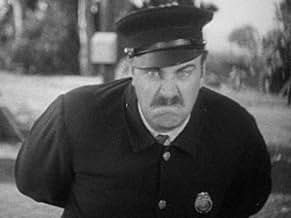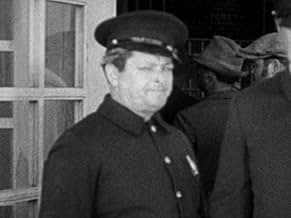Aggiungi una trama nella tua linguaSwept up in a police raid, Stan and Ollie are sentenced to jail and land in a jail labor camp. The governor visits, accompanied by two flappers, where the duo accidentally create rice puddin... Leggi tuttoSwept up in a police raid, Stan and Ollie are sentenced to jail and land in a jail labor camp. The governor visits, accompanied by two flappers, where the duo accidentally create rice pudding for a food fight.Swept up in a police raid, Stan and Ollie are sentenced to jail and land in a jail labor camp. The governor visits, accompanied by two flappers, where the duo accidentally create rice pudding for a food fight.
- Regia
- Sceneggiatura
- Star
- Prisoner
- (non citato nei titoli originali)
- Party Guest
- (non citato nei titoli originali)
- Party Guest
- (non citato nei titoli originali)
- Prisoner
- (non citato nei titoli originali)
- Prisoner
- (non citato nei titoli originali)
- Party Guest
- (non citato nei titoli originali)
- Prisoner
- (non citato nei titoli originali)
- Prisoner
- (non citato nei titoli originali)
- Prisoner
- (non citato nei titoli originali)
- Prisoner
- (non citato nei titoli originali)
- Governor
- (non citato nei titoli originali)
- Treetop Lookout
- (non citato nei titoli originali)
- Prisoner
- (non citato nei titoli originali)
- Prison Camp Officer
- (non citato nei titoli originali)
- Party Guest
- (non citato nei titoli originali)
- Prison Guard
- (non citato nei titoli originali)
Recensioni in evidenza
This is one of the first times I've seen where slapstick really works for Laurel and Hardy. The Hoose-Gow doesn't make much of an effort to incorporate a lot of verbal wit, and instead, emphasizes the physical elements. For some reason, perhaps the result of a mood-change or an unconscious desire, I was pleased by the slapstick here, especially during the scenes when Hardy is attempting to cut down a tree and Laurel keeps getting in the way, nearly missing the sharp blade of the pickaxe. Scenes like that provide for slapstick that almost seems improvisational rather than a copout for screen writing.
One can tell, however, this is an early sound-short because of the lack of formal dialog. The Hoose-Gow could've really been a silent short and simply had the timely luxury of being able to be produced with sound. My only assumption to the lack of real conversation was writers at the time, in this case, H.M. Walker, who wrote most of Laurel and Hardy's short films, was just getting used to screen writing with audible dialog, making the early sound-shorts lack the kind of leisurely- paced dialog that would be present in Laurel and Hardy's later shorts. It's not a particular flaw, just a difficultly in adapting on part of the short's crew, but it would've made for a more witty short.
Yet The Hoose-Gow accomplishes a feat I never really thought possible with Laurel and Hardy shorts, which is make them more slapstick driven than dialog driven and have them turn out successful. For that, the film deserves a huge plus, and the fact that this is the most active I've seen both men in any project only adheres to their credibility has fantastic physical performers.
Starring: Stan Laurel and Oliver Hardy. Directed by: James Parrot.
This early talkie is rather unpolished in construction, but Stan & Ollie are always fun to watch. Slapstick humor abounds, especially in the finale. James Finlayson plays the Governor.
Although a vast majority of Laurel and Hardy's previous efforts ranged from above average to very good ('45 Minutes from Hollywood' being the only misfire and mainly worth seeing as a curiosity piece and for historical interest, and even that wasn't a complete mess), 'Two Tars' for me was their first truly classic one with close to flawless execution. Didn't find 'The Hoose-Gow' as one of their best and a bit disappointing compared to their late 1928 and previous 1929 efforts, which were among their best and funniest early work. It is still good with a lot of great merits.
It may not be "new" material as such, some rather familiar material here and the first part takes a little bit too time to get going.
Compared to the late 1928 and previous 1929 output, it is a little on the subdued and bland side, contrary to the insane craziness and wacky slapstick that was properly starting to emerge.
When 'The Hoose-Gow' does get going, which it does do very quickly, it is good enough fun, not really hilarious but never less than amusing. It is never too silly, the energy is there and the sly wit is here, some of the material may not be new but how it's executed actually doesn't feel too familiar and it doesn't get repetitive.
Laurel and Hardy are on top form here, both are well used, both have material worthy of them and they're equal rather than one being funnier than the other (before Laurel tended to be funnier and more interesting than Hardy, who tended to be underused). Their chemistry feels like a partnership here too, before 'Two Tars' you were yearning for more scenes with them together but in 'The Hoose-Gow' we are far from robbed of that. Their comic timing is impeccable.
'The Hoose-Gow' looks mostly good visually (even if the polish is not always there), has energy and the direction gets the best out of the stars, is at ease with the material and doesn't let it get too busy or static. The supporting players are solid.
Overall, very good. Not essential or classic Laurel and Hardy but hardly disgraces them either. 7/10 Bethany Cox
Any short film that needs a great deal of set up before it actually starts going anywhere, is asking for trouble. On the surface that may not totally be the case here but I suspect it is one of it's weaknesses. The plot here sounds good but it has a few little unnecessary things that are needed to get it to it's original idea (I assume) which is the prison gang.
Once it reaches this stage it is funny but never feels like it reaches a peak. Individual moments are good but it doesn't have any really good sequences I found the rice fight to be so-so rather than hilarious I'm afraid.
Laurel and Hardy are good of course but they seem to be hampered by a film that requires them to do things that aren't funny just to set up a joke that is funny. This split of time is almost 50/50 so the result is that the film doesn't seem to be as full and lively as their shorts are normally. Finlayson is usually my favourite support actor in the Laurel and Hardy shorts but here he doesn't get to do his trademark moves and is more of a straight man than a part of the comedy.
Overall this is still worth watching but I thought it was one of those rare occasions where the duo simply couldn't stretch the central idea to cover the whole short.
Lo sapevi?
- QuizOliver Hardy was injured during the filming of the scene in which Stan Laurel keeps nicking him with a pickaxe. A rubber pickaxe was originally to have been used for the scene, but it was decided that it looked too fake, in action, so a real one was substituted. Hardy moved a little too close to Laurel during the latter's backswing and received a very real cut from the pickaxe on his rear.
- BlooperAt the end of the film the car backs into the truck, just before the impact two barrels of whitewash tip over.
- Citazioni
Title Card: Neither Mr. Laurel nor Mr. Hardy had any thoughts of doing wrong - As a matter of fact, they had no thoughts of any kind
- Versioni alternativeThere is also a colorized version.
- ConnessioniFeatured in The Crazy World of Laurel and Hardy (1966)
I più visti
Dettagli
- Data di uscita
- Paese di origine
- Sito ufficiale
- Lingua
- Celebre anche come
- The Hoose-Gow
- Luoghi delle riprese
- Azienda produttrice
- Vedi altri crediti dell’azienda su IMDbPro
- Tempo di esecuzione21 minuti
- Colore
- Mix di suoni



































